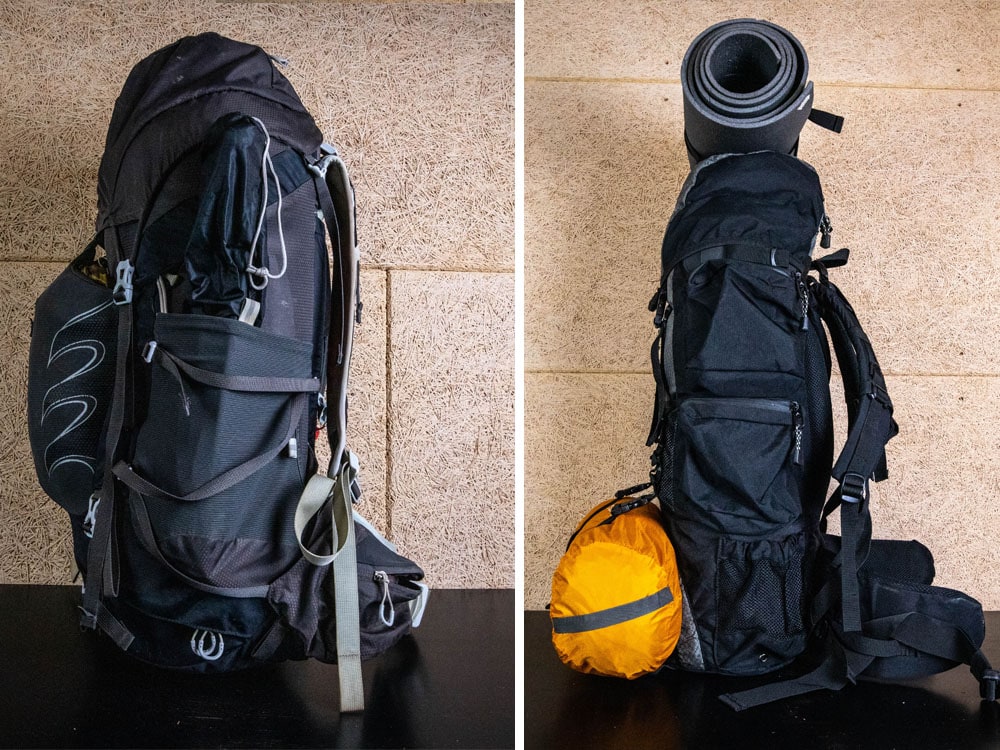In my opinion, every hiker should know how to attach tents to their backpacks correctly. It’s so important, because tents are the most important pieces of hiking gear, along with good backpacks. You need to make sure that they’re protected, dry, and packed in a way that doesn’t end up hurting your back and shoulders.
That’s why in this article, you’ll learn the best way to attach a tent to a backpack, and what other things you should look out for. I’ve lived for 36 days out of my tent on a thru-hike in the Pyrenees mountains, so I know how important it is.
Why You Should Avoid Attaching Your Tent to the Exterior of Your Backpack
A lot of articles online about this subject will tell you to attach your tent to the exterior of your backpack, but that’s not good advice. If you want to avoid having back pain, you should always pack the heaviest items, such as your tent, in the middle of your backpack, and as close to your back as possible.
When you attach a tent to the outside of the backpack, regardless if it’s attached to the top, the bottom, or in the middle, but too far from your back, you’re putting a lot of weight away from the center of your body mass. Your body wants to stay balanced, so your shoulders, back muscles, and spine will make up for it, by tightening up and staying engaged. If, however, the heaviest items are packed closer to your back (such as your tent) the weight is evened out and spread out across all of your muscles evenly, even your legs. You need to understand this concept if you don’t want to experience shoulder pain at the end of a long day of hiking.
Even though back pain is the most important reason why you shouldn’t be attaching your tent to the exterior, there are others. When attached to the outside with compression straps, drawstrings, rope, or even carabiners, any element could fail and you could lose your tent. It could also get damaged from any sharp rocks or branches, or get wet if you wouldn’t be using a rain cover.
Read Next: Calculating Your Average Torso Length Relative to Height
Different Ways of Attaching a Tent to a Backpack (From Best to Worst)
Ideally, you should go with options 1-3, unless you have zero space left in your backpack. If so, consider upgrading to a larger backpack, leaving some unneeded items behind, or getting ultralight gear.
Option 1: Disassembling the Tent and Packing It at the Bottom of the Backpack
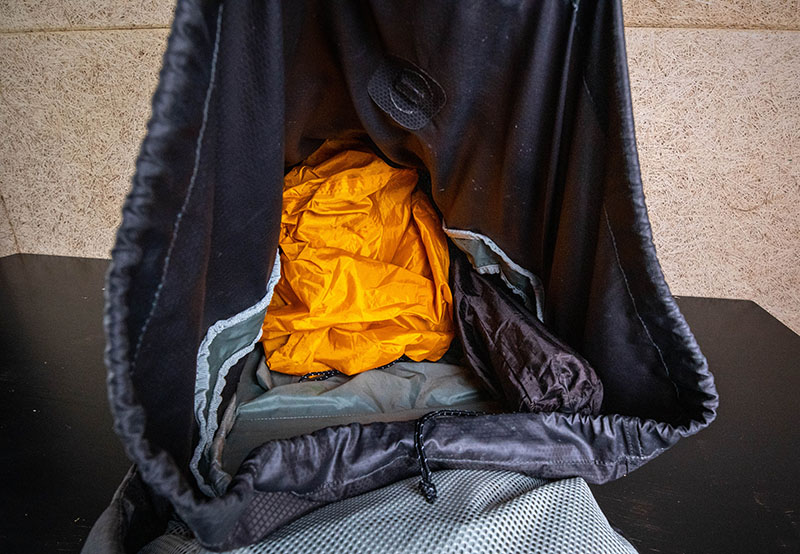
The first, and best option, in my opinion, is to get rid of your tent bag and pack each part of your tent individually inside the backpack. You should pack the inner tent and the rainfly inside the backpack at the bottom of the main compartment because essentially, they’re just pieces of fabric and they aren’t too heavy. You can just squeeze them at the bottom of the pack without rolling or folding them, as it’s the most efficient way to use up the space. Don’t worry if they’re still a bit damp from the last night, as you’ll be packing them at the bottom of the main compartment – away from your other gear.
Follow by placing the poles in the main compartment vertically on either side of the backpack closer to your back, as they’re one of the heaviest elements of the tent. Squish your sleeping bag and inflatable sleeping pad on top of your rain fly and inner tent, and place the heaviest items on top (camping stove, food, tent stakes, e.t.c). You should be left with some space left on top of the main compartment, where you should pack your lightest items, such as your spare clothing. If there isn’t enough space for everything, proceed to option 3 or attach the lightest items to the exterior of your pack.
Option 2: Packing the Tent Inside the Main Compartment Without Disassembling
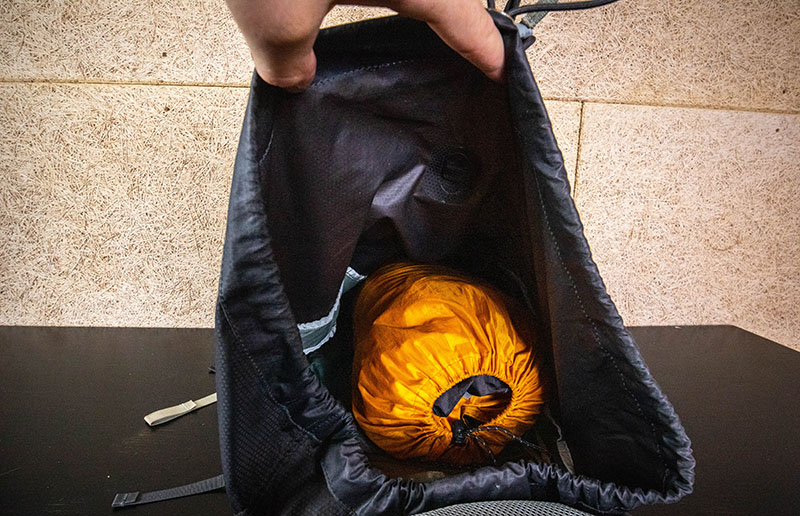
Another option would be to just stuff your tent inside the main compartment without much thought. That way your tent would stay in a single bag and it would be easier to take it out of the backpack when you’re ready to set it up. The only tradeoff is that you won’t be using up the total space of the main compartment efficiently, and most likely the inner compartment won’t be packed in a way that’s good for your back (lightest items on top/bottom and heaviest in the middle, closer to the back.)
Honestly, this is still a good way to pack a tent, as from my own experience, the way in which items are organized in the main compartment doesn’t make too much difference in terms of comfort and back pain.
Read Next: How to Keep Your Feet From Sliding Forward in Hiking Boots
Option 3: Disassembling the Tent and Attaching It to the Exterior of the Backpack
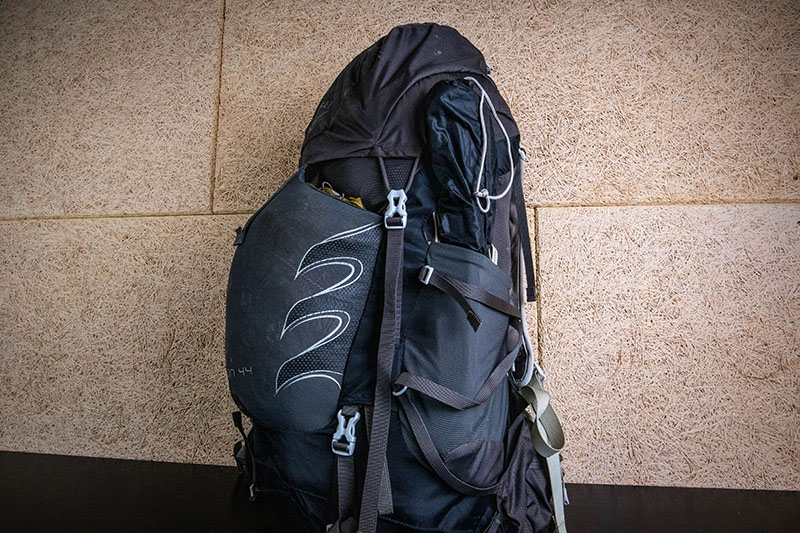
Another efficient way of attaching tents to backpacks is by disassembling them and by stowing all the fabrics (rainfly, inner tent, footprint) in a large stretchy pocket in the middle of the pack, and placing your poles and stakes to either side of the backpack. The fabrics usually aren’t too heavy, so it doesn’t make much difference if they’re attached to the outside, and by placing poles at the sides, they’re very close to your center of mass.
This technique is used by a lot of ultralight hikers because you can get away with using a backpack that’s smaller in volume, which will save some weight. If the rainfly and the inner tent become wet from morning dew, your other pieces of gear won’t get damp because they’ll be attached to the outside of the pack.
Option 4: Attaching the Tent to the Bottom of the Backpack
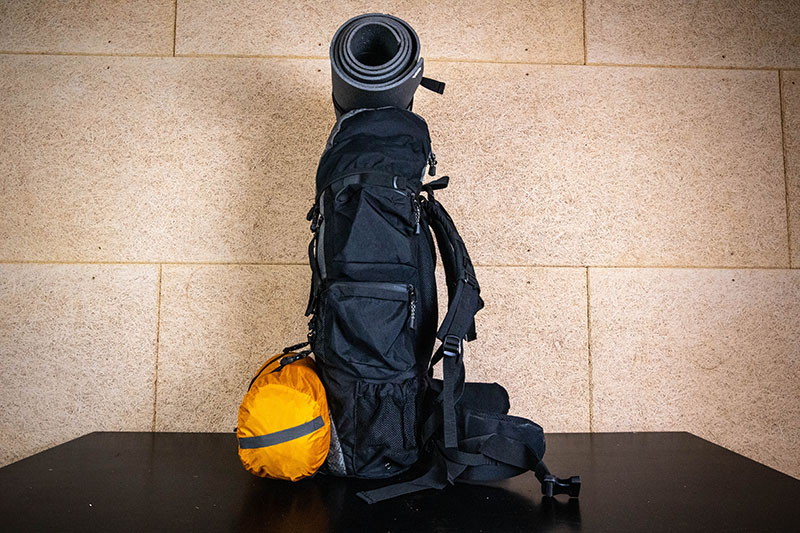
If you really have no space left inside your main compartment and your backpack doesn’t have a large-enough exterior pocket in the middle (or if it’s already full) then the best way is to attach your tent to the bottom of your backpack. Some backpacks come with straps that are meant for this purpose, but if they don’t you can also use regular rope, drawstrings, or carabiners. Just make sure to attach it safely, and double-check that your tent will stay there.
If you have a rolled-up foam sleeping pad, it’s best to attach it to the top of your backpack and keep your tent at the bottom, because the top of your backpack (anything above shoulder straps) is the worst place to attach heavy items and it will surely end in a lot of shoulder pain.
Option 5: Attaching the Tent to the Top of the Backpack

Try not to attach your tent to the top of your backpack, as it will result in too much shoulder pain. Instead, if you’re out of space, try swapping your tent with other, lighter gear, and place the lighter gear on top of the backpack. You can attach gear to the top of your backpack with drawstrings, rope, or compression straps.
Read Next: Is It Okay to Hike in Jeans or Should You Buy Hiking Pants?
Things to Watch Out for When Attaching a Tent to Your Backpack
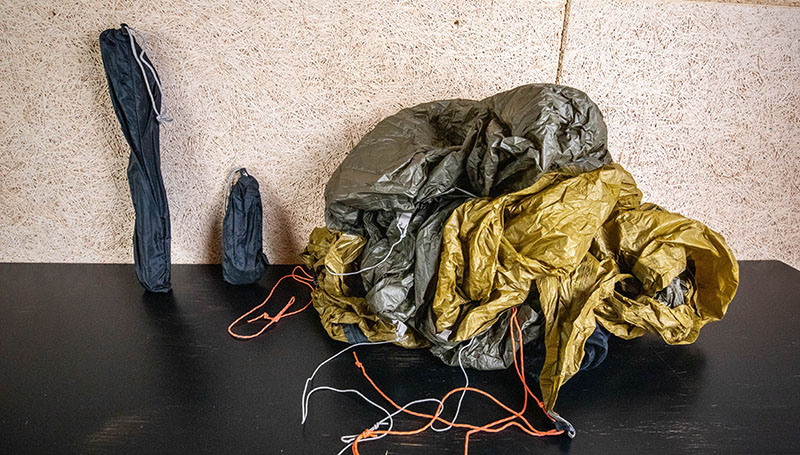
Even though we already covered some of them, here are the most important things you should look out for when attaching a tent to your backpack:
- It’s better to disassemble your tent. You don’t really need to bring the tent bag, as you’re trying to save as much weight as possible. By disassembling your tent, you can stash your rainfly and inner tent separately in the main comaprtment, without rolling or folding them, which is a more efficient way to use up the space inside the backpack.
- It’s better to keep your tent inside the backpack. Unless it’s an ultralight tent, usually tents are one of the heaviest pieces of gear, and you should always keep the heaviest items inside of the backpack, if you want to avoid shoulder and back pain.
- Keep your tent as close as possible to your back. You want the heaviest items to be packed closer to your back because that way the weight will be spread out across all of your muscles, instead of only the shoulders and back muscles. Also, try to pack the heaviest items towards the middle of the pack, not top of bottom.
- If attached to the outside, make sure the tent will stay intact. Your tent is the only thing that will keep you protected from the elements, so make sure to safely secure it to your backpack. Also, make sure that the tent bag is securely closed, so your stakes, guylines, or poles, don’t accidentally fall out.
- If attached to the outside, keep the inner tent dry. If your backpack comes with a rain cover that fits over everything, even the gear that’s attached to the outside, you should be good. But if not, most tents come with a bag that isn’t waterproof, so when you pack your tent, wrap the inner tent inside the rainfly, to keep it from becoming wet in case you encounter some rain.
- If attached to the outside, try not to rip your tent. Whenever you attach your tent to the outside of your backpack, you’re exposing it to whatever the trail decides to throw in your path. So if you accidentally lose the way and end up bushwacking, try not to rip your tent on sharp branches.
- When attached to the outside, it’s better to attach it at the bottom rather than the top. When you attach heavy things to the top of your backpack, it screws up your centre of mass, and your shoulder and back muscles make up for it. Even though attaching your tent at the bottom of the pack isn’t perfect either, it’s much better than attaching it to the top.
- Choose an internal frame backpack. If you’re looking up how you should be attaching your tent, chances are that you’re just getting into hiking and your gear is pretty heavy. When carrying heavy, medium-weight, or even lightweight gear, it’s essential to get a backpack with an internal frame. The internal frame spreads out the total weight accross your body. With a frameless pack, all of the weight is concentrated towards the shoulders. Ultralight hikers can get away with that because their setups are so lightweight that internal frame isn’t really needed.
Final Words
It’s really important to properly pack your gear inside your backpack, storing the heaviest items closer to your back and towards the middle of the pack. People who are new to hiking, usually bring a lot of gear, and what’s worse – they attach the heaviest items to the outside of the backpack (such as their tents), not knowing that’s the main reason why their backs end up hurting. So hopefully, you won’t be like them from now on, and you’ll know how to pack your tent inside your backpack in a way that’s good for your back.
